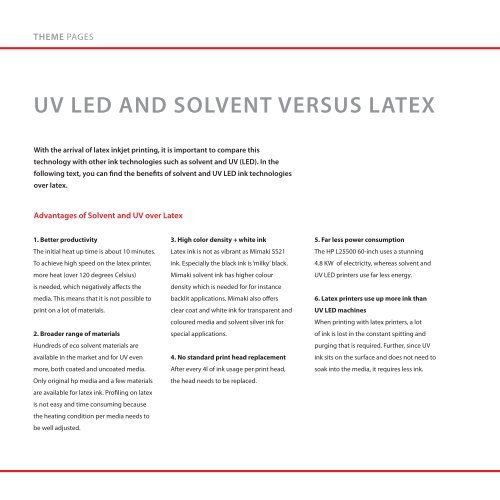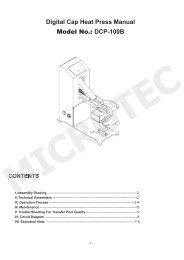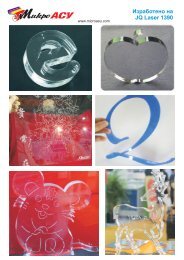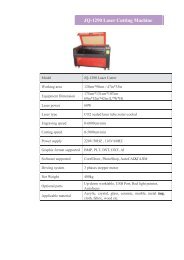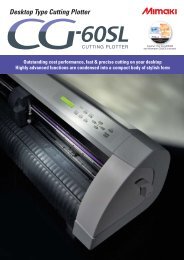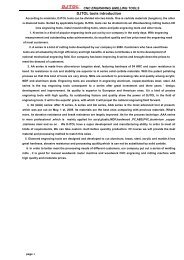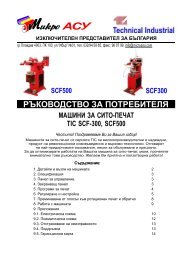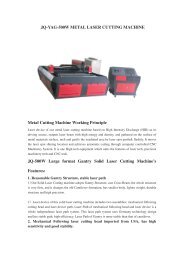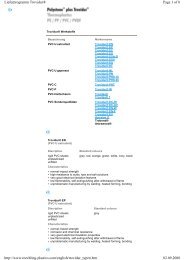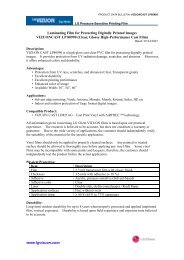Mimaki Guide 2011.pdf - HOME
Mimaki Guide 2011.pdf - HOME
Mimaki Guide 2011.pdf - HOME
You also want an ePaper? Increase the reach of your titles
YUMPU automatically turns print PDFs into web optimized ePapers that Google loves.
THEME PAGESTHEME PAGESUV LED AND SOLVENT VERSUS LATEXDYE SUBLIMATION PRINTINGWith the arrival of latex inkjet printing, it is important to compare thistechnology with other ink technologies such as solvent and UV (LED). In thefollowing text, you can find the benefits of solvent and UV LED ink technologiesover latex.Print to any polyester or polyester-coated substrate or product• Use <strong>Mimaki</strong> TPC, TS, JV33, JV5, TX and DS series printers• Post treatment with any heat press• Create anything from T-shirts to handbags, mugs to mouse mats and everything in between!TPC-1000Advantages of Solvent and UV over Latex1. Better productivityThe initial heat up time is about 10 minutes.3. High color density + white inkLatex ink is not as vibrant as <strong>Mimaki</strong> SS215. Far less power consumptionThe HP L25500 60-inch uses a stunningChoose your printer :sublimation or direct?Next step: inksYou cannot print to the transfer paper withProducts<strong>Mimaki</strong> JV33, JV5, JV22 andTo achieve high speed on the latex printer,ink. Especially the black ink is ‘milky’ black.4.8 KW of electricity, whereas solvent andFirst off, what do you want to print?old inks. <strong>Mimaki</strong>’s sublimation inks haveJV4 series aqueous graphicsmore heat (over 120 degrees Celsius)<strong>Mimaki</strong> solvent ink has higher colourUV LED printers use far less energy.There are two ways. If you are producingspecial properties, are water-based and areinkjet printers.is needed, which negatively affects thedensity which is needed for for instancesomething that requires a lot of showdesigned to directly print to polyester or<strong>Mimaki</strong> TX and DS Series directmedia. This means that it is not possible tobacklit applications. <strong>Mimaki</strong> also offers6. Latex printers use up more ink thanthrough, say, flags or two-way soft signage,via sublimation paper.to textile inkjet printers.print on a lot of materials.clear coat and white ink for transparent andcoloured media and solvent silver ink forUV LED machinesWhen printing with latex printers, a lotthen use a <strong>Mimaki</strong> TX400 or JV5-320DS.However, for the majority of sublimationFinal step: heat press/calendar<strong>Mimaki</strong> and Sublimation Inks with hugegamut and excellent runability.2. Broader range of materialsspecial applications.of ink is lost in the constant spitting andprinting (apparel, sportswear, andThe final part of the process is to eitherHundreds of eco solvent materials arepurging that is required. Further, since UVpromotional products, such as mouse mats,press the fabric (when printing direct) oravailable in the market and for UV even4. No standard print head replacementink sits on the surface and does not need tomugs, et cetera.), printing to sublimationthe paper with the fabric when subliming.more, both coated and uncoated media.After every 4l of ink usage per print head,soak into the media, it requires less ink.paper is the most accurate and easy to use.At temperatures of between 180° andOnly original hp media and a few materialsthe head needs to be replaced.220°, the ink changes from liquid to gasare available for latex ink. Profiling on latexand is released from the paper, thenis not easy and time consuming becauseattaches itself to the polyester. After that,the heating condition per media needs tothe print becomes washfast and lightfast.be well adjusted.In the case of a print onto fabric, does notalter the handle whatsoever.Tx400-1800D


